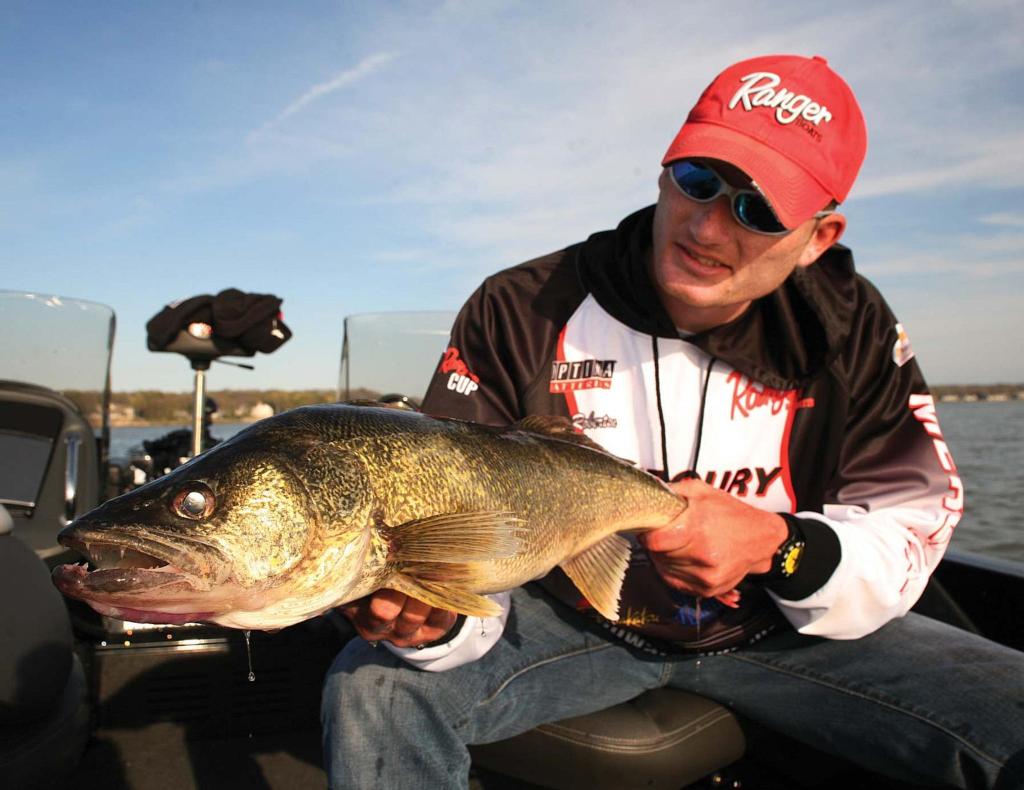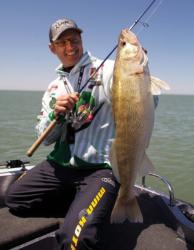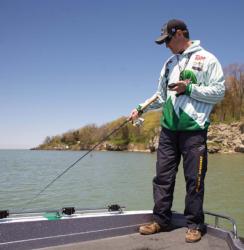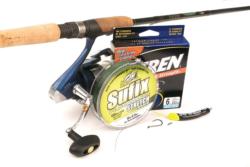Max rigging
How to change your rigging system to maximize the deep bite

Nothing is the same 72 feet below the surface.
That is, nothing is the same in the deepest depths of walleye country as it is in the 10- to 30-foot range where most walleye anglers fish. In fact, once you cross the 50-foot mark, the thick band of water between the surface and giant bottom-dwelling walleyes calls for an entirely different set of presentation skills, especially when it involves a live-bait rig.
Yet, during the 2010 National Guard FLW Walleye Tour Championship, many of the top finishers were targeting walleyes with live bait 50 feet deep and deeper, with the deepest reported being a staggering 72 feet.
At that range, they had to modify tackle, landing techniques, boat control and electronics use for a more efficient live-bait rigging presentation. Because in the deep, nothing is the same.
When and why
Before plying the extreme depths of a local lake, you have to answer a couple of questions: When do walleyes go that deep, and why are they there?
The answers are simpler than most might think. From late summer into early fall, inland lakes experience major temperature changes. Cooler nights result in a drop in the water temperature, which causes walleyes and baitfish to reposition to deeper structure over time. The baitfish move because they can’t survive in temperature extremes. The walleyes move because they can’t survive without their food.
In most cases, the baitfish that inhabit deep structures are the largest in the system. These might include tullibees, ciscoes and a variety of chubs. Large, fatty baitfish are like candy to walleyes looking to pack on fat before the long winter. So where the baitfish go, the walleyes go.
What to look for
While no two situations in fishing are ever the same, this early fall technique seems to be somewhat universal in terms of where to look. Scope out large bays that have quick access to deep water. These are usually annual migration routes for both baitfish and walleyes.
Within the bay, look for prominent structures rising from the depths of the basin.
“I want to see humps on top of these deep structures,” says AMP Energy/Diet Mountain Dew pro John Balla of Bartlett, Ill. “That is where the active fish move to feed.”
 At Walker Bay in Leech Lake, where Balla spent much of the championship tournament, many of the structures he fished were the most obvious humps in the bay. The structures rose from the deep basin quickly, and had steep sides. By keying on humps, Balla was able to search each individual structure quickly, rather than having to scan back and forth along a long, continuous drop-off. This saved a lot of search time.
At Walker Bay in Leech Lake, where Balla spent much of the championship tournament, many of the structures he fished were the most obvious humps in the bay. The structures rose from the deep basin quickly, and had steep sides. By keying on humps, Balla was able to search each individual structure quickly, rather than having to scan back and forth along a long, continuous drop-off. This saved a lot of search time.
Making quick work
The search starts by idling with the big engine, surveying deep humps that are seen easily on most GPS map chips. At that depth, Balla doesn’t worry about spooking walleyes with the noise of the motor. Plus, the large-diameter cone that a transducer emits in this deep water allows for scanning large paths of water very quickly.
The goal of the exercise is to mark walleyes, not just baitfish, so you have an idea of exactly where to start and where to present a bait. Keep in mind that just because you don’t see a fish on the graph, it doesn’t mean they aren’t there. But the best way to know big, active walleyes are present is when you mark at least a fish or two on the graph.
At the championship, many of the top finishers that were live-bait rigging pieced together a series of deep-water spots into a milk run. Then, each day, they went from spot to spot, using their electronics to relocate fish on each structure and dropping live-bait rigs down to them.
The technique
The presentation for rigging deep walleyes doesn’t vary greatly from that of rigging for shallow walleyes. In fact, because you don’t have to worry as much about spooking fish with the boat, some parts of it are easier.
The more difficult parts are getting good hooksets, controlling the boat and fighting fish. According to Balla, you must be constantly aware of how much line is out. The line has to be kept as close to vertical as possible. Even a slight line angle over 50 to 70 feet of water equates to a major difference between where you think the bait is and where it actually is, which makes it difficult to put the bait in the face of a fish appearing on the graph as being directly below the boat.
Control line angle by increasing the weight of the sinker (a quick-change sinker makes this easy), and by constantly “checking” for the bottom without dragging the weight.
Rigging in deep water is a saturation game. When Balla finds a spot with fish, he works that spot intensely. He wants to seine the spot thoroughly before moving on. For this reason, he keeps his rigging speeds in the 0.6- to 0.8-mph range.

This requires careful boat control. For those walleye anglers who rely on a tiller-steer motor, they’re already at an advantage. For the rest, Balla has a trick that he developed using his bow-mounted Minn Kota Terrova: He actually uses the wireless remote to control the bowmount while fishing from the stern. For starters, this makes it much easier to combat waves and stay drier.
The biggest benefit of this system, however, is in the ease of making tight boat turns to circle back over a good spot. If you don’t have a remote-controlled trolling motor, use a transom-mounted kicker or electric motor, waves permitting.
Fishing from the back with a partner causes fewer tangles during turns, as it’s easier to keep lines separated. If one angler were to fish from the front and the other from the back, the odds of a tangle when turning the boat are high. In fact, many anglers often reel up one line to prevent a tangle when turning the boat, which means less time with bait in the water. That’s not necessary when fishing from the back, as the stern becomes somewhat of a pivot point, while the bow swings around. Lines stay directly beneath the boat, and right in front of any walleyes.
Picture a bicycle wheel: The distance the tire moves is much greater than the distance the gear in the center of the wheel moves in one rotation. It’s the same thing in the boat. Being closer to the rear, lines move far less during a turn than they would if fished at the bow, even if you’re constantly turning the boat to fish and re-fish a productive spot.
And that’s the key to the technique. Once on a spot with fish, constantly work through it until you either catch fish or exhaust the means to catch them.
Improving landing percentage
There are more opportunities for fish to come unbuttoned when fighting them up from deep water than in the shallows. For one thing, it’s harder to get a good hookset with a lot of line out because of stretch, and more line needs to be reeled in. The fact that the large chubs or shiners commonly used during autumn need to be “fed” to the walleyes before the hook is set only complicates matters.
Many anglers will choose to use their standard big-chub, live-bait rigging hookset technique of feeding line for up to a minute, reeling up slack and using a sweep set. That’s fine. It will work, but in deep water it has a major drawback. As mentioned earlier, it’s easy to end up with a large bow or angle in the line in deep water. Also, a walleye allowed to run free can cover some ground after it eats a chub, and you never really know how far away it is or in what direction it swam. That can lead to many fish lost during the “feeding” process.
Balla instead uses what might be termed the “trolling hookset.” Instead of backing up or stopping the boat when he feels a bite, he continues in the direction he was heading. The goal is to eliminate the steep line angle and stretch the line almost parallel to the fish. All the while he will be feeding line for as much as a minute. Then, once he feels the fish has had it long enough, Balla reels in the slack and feels if the fish is still on. From there he reels any additional slack and uses a long sweeping hookset. Doing it this way, he always knows where the fish is in relation to the boat, and he experiences much greater success with this technique than a traditional live-bait rig hookset.
Capt. Ross Robertson guides on lake Erie’s western and central basins for big walleyes and educational trips. Contact him at (419) 283-7069 or bigwaterfishing.com.

Deep rigging gear
Deep live-bait rigging requires special gear, not only for perfectly placing the bait, but for handling big walleyes during what can be a long fight to the surface. Here is how John Balla gears up for deep battles.
Balla’s equipment choice
• Rod and reel – Balla will use a spinning rod when live-bait rigging, but he actually prefers to use a baitcasting rod with a reel that has a flipping switch feature. He feels that this setup makes it easier to fish two rods (where legal) because he can drop or pick up line quickly and with one hand as he works up and down a hump. Balla likes a rod with a somewhat soft tip with enough backbone both to set the hook in deep water and accommodate large sinkers.
• Line – A thin-diameter braided line offers sensitivity and is able to be fished vertically under the transducer.
• Leader – He opts for mono as a leader because it doesn’t sink, which keeps his bait in the proper strike zone, and because it provides a little extra shock absorption when paired with the stretch-free braided main line.
• Hook – Balla uses a red No. 2 Gamakatsu Octopus Hook.
• Sinker – He uses a 1-ounce Lindy No-Snagg Slip Sinker because there is less surface area in the sinker’s eye to feed the line through when compared to traditional egg sinkers. That means less friction and less chance of a fish feeling the weight as it runs with the bait. If he needs to keep his line more vertical, in the deepest of waters, he’ll also use a traditional 1 1/2-ounce shoe-style Lindy sinker.